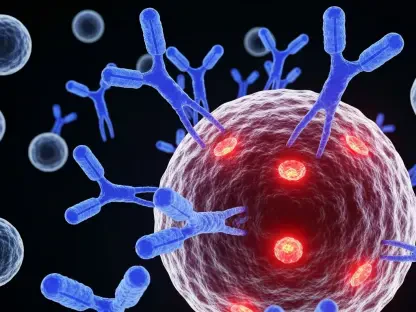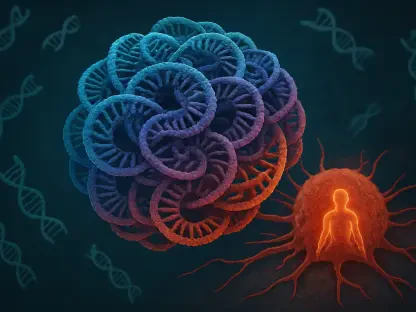Hypoxia, often associated with adverse environmental conditions, has recently emerged as a significant player in the progression of colon cancer. Once considered mainly a problem in cancer treatment due to its potential to inhibit tumor growth by starving the cancer cells of oxygen, new insights reveal that hypoxia can, paradoxically, fuel tumor development. This shift in understanding challenges previous therapeutic strategies and opens up discussions on the future of cancer treatments.
The Current State of Hypoxia Research in Cancer
In the realm of cancer research, significant strides have been made in understanding the role of hypoxia. Historically viewed as an obstacle to tumor progression, it was leveraged as a point of attack, with treatments designed to cut off the oxygen supply. However, recent developments indicate that hypoxia might actually accelerate tumor growth in certain types of cancer, including colon cancer. This revelation marks a significant turning point, encouraging researchers and medical professionals to reconsider how cancer therapies are conceptualized and applied.
The evolving understanding of hypoxia’s impact on colon cancer is reshaping scientific discussions. It underscores the importance of studying the tumor microenvironment, emphasizing the need to focus not just on cancer cells but also on the surrounding cellular dynamics. This paradigm shift highlights hypoxia as more than a simple lack of oxygen but as a complex biological state influencing cancer behavior and treatment approaches.
Detailed Analysis: Mechanisms and Challenges
Fibroblast Transformation Under Hypoxic Conditions
In the hypoxic environment of colon tumors, ordinary fibroblasts undergo a significant transformation. Typically, fibroblasts play a supportive role in maintaining tissue structure, but under low oxygen levels, they can morph into inflammatory cells. This transformation involves releasing key factors such as epiregulin and Wnt5a, which contribute to sustaining the hypoxic state, thereby promoting tumor growth. This discovery suggests a more nuanced role for fibroblasts, underscoring their potential as therapeutic targets within the tumor microenvironment.
The interplay between fibroblasts and cancer cells is crucial in understanding tumor dynamics. Fibroblasts are now recognized as significant contributors to the tumor-promoting ecosystem, forming a symbiotic relationship with cancer cells. This relationship necessitates a reevaluation of therapeutic strategies, potentially shifting focus from direct cancer cell targeting to modulating the activity of surrounding fibroblasts.
Role of Key Proteins and Signals
Central to hypoxia-driven tumor growth are proteins such as epiregulin and Wnt5a, which are instrumental in colon cancer progression. Epiregulin facilitates tumor growth, while Wnt5a prevents the formation of new blood vessels that would normally alleviate hypoxia. This intricate signaling pathway and protein interaction amplify the impact of hypoxia on the cancer microenvironment, indicating the need for more comprehensive treatment strategies that address multiple facets of tumor biology.
These signaling pathways reveal the complexity of cancer progression under hypoxic conditions and present new opportunities for intervention. Understanding the molecular interactions that exacerbate hypoxia provides a pathway for developing treatments that inhibit these specific signals, aiming to disrupt the favorable conditions hypoxia creates for tumors.
Challenges and Implications for Treatment
Despite progress in understanding hypoxia, current treatment strategies aimed at limiting tumor oxygen supply have shown contradictory results. While these approaches were initially designed to weaken tumors, they might inadvertently empower them by exacerbating hypoxic conditions. This paradox illustrates the limitations of existing therapies, highlighting the urgent need for solutions that can effectively navigate and manipulate hypoxic microenvironments without empowering cancerous cells.
Beyond colon cancer, insights from hypoxia research have implications for broader cancer and inflammatory disease therapies. The potential therapeutic targets extend beyond fibroblasts, suggesting new avenues of treatment for diseases like inflammatory bowel disease. The findings push the boundaries of traditional cancer therapy, advocating for broader investigations into how inflammatory processes might be modulated in chronic diseases.
Future Directions in Colon Cancer Treatment
Future advancements in colon cancer treatment hinge on leveraging emerging technologies and innovative strategies targeting hypoxia-induced pathways. The role of precision medicine becomes increasingly significant, offering personalized approaches that consider individual biological responses to hypoxia. This shift could lead to more effective treatment regimens that are tailored to the specific needs and conditions of patients, paving the way for improved clinical outcomes.
Investment in new treatment paradigms also has market implications, potentially transforming the landscape of cancer treatment. As our understanding of hypoxia’s role in cancer pathology deepens, the development of novel therapies that precisely target the hypoxia-fibroblast dynamic could revolutionize standard practices, allowing for more durable and targeted interventions.
Conclusion
In recent years, research has dramatically reshaped our understanding of hypoxia’s influence on colon cancer growth. The findings revealed the potential of hypoxia to facilitate rather than deter tumor development, highlighted by fibroblast transformations and the intricacies of protein signaling pathways. These insights have underscored previously unappreciated dynamics within the tumor microenvironment. Going forward, more focused research into hypoxia’s role and fibroblast interaction is necessary.
Strategically targeting the transformed fibroblasts and specific molecular signals holds promise for crafting a new era of cancer treatment. By advancing these methodologies, the medical community can work towards more effective and nuanced therapies that leverage hypoxia’s complexities to improve patient outcomes across various cancers and chronic inflammatory diseases.









